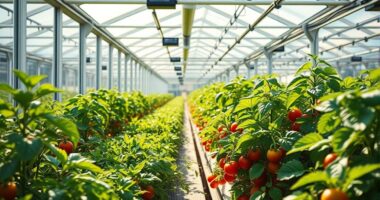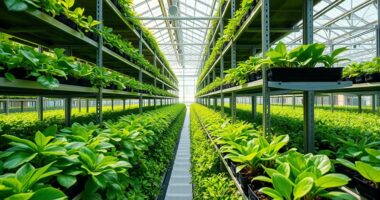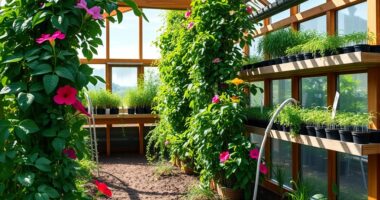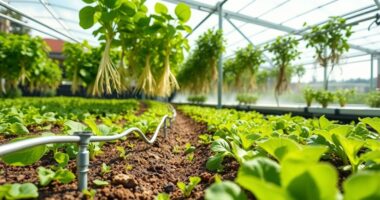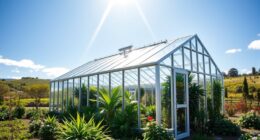Microclimate zoning in your greenhouse involves dividing it into distinct areas with tailored conditions to optimize plant health and resource use. You can manage these zones by adjusting plant spacing, which influences airflow and humidity, and selecting appropriate irrigation methods—like drip or misting—to suit each area’s needs. Combining these strategies helps create ideal microenvironments, reducing disease risk and improving growth. Explore further to learn how fine-tuning these factors maximizes your greenhouse’s productivity.
Key Takeaways
- Divide the greenhouse into zones based on climate needs to optimize plant growth and resource use.
- Adjust plant spacing within each zone to improve airflow, reduce disease risk, and enhance light penetration.
- Implement tailored irrigation methods—like drip or misting—according to each zone’s humidity and moisture requirements.
- Integrate plant spacing and irrigation strategies to create balanced microenvironments and prevent issues like overcrowding or overwatering.
- Regularly monitor lighting, humidity, and temperature to refine zoning practices and ensure optimal conditions across all zones.
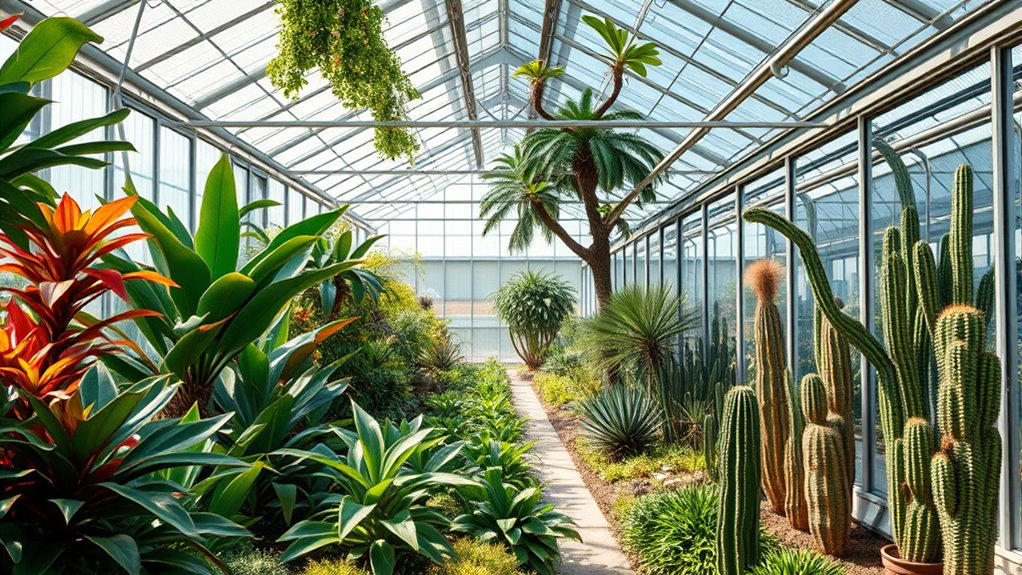
Microclimate zoning involves dividing a specific area into smaller sections based on local climate conditions to enhance land use and environmental management. When managing a greenhouse, this technique allows you to tailor conditions to suit different plant needs, guaranteeing each zone receives the appropriate care. One of the key elements in effective microclimate zoning is understanding how plant spacing influences microenvironmental factors. Proper plant spacing isn’t just about giving plants room to grow; it also affects airflow, humidity, and temperature within each zone. Spacing plants too closely can trap heat and humidity, leading to increased disease risk, while too much space might waste valuable space and resources. By adjusting plant spacing according to each zone’s microclimate, you can optimize airflow and light penetration, creating healthier growing conditions.
Equally important is selecting suitable irrigation methods for each zone. Different microclimates demand different watering strategies to maintain ideal soil moisture and plant health. For example, in a zone with higher humidity and lower airflow, drip irrigation can deliver water directly to roots with minimal evaporation, reducing the risk of fungal diseases. Conversely, in a drier, sunnier zone, overhead sprinklers or misting systems might be more effective to increase humidity and keep plants hydrated. Tailoring irrigation methods to each microclimate ensures you use water efficiently and prevent issues like overwatering or underwatering, which can stress plants and hamper growth.
As you implement microclimate zoning, consider how plant spacing and irrigation methods work together. In zones with dense plantings, you might need to increase airflow through strategic spacing and use irrigation techniques that reduce excess moisture. In contrast, open areas may require more frequent watering or humidity control to support plant health. Additionally, incorporating proper lighting conditions can further enhance plant growth within each zone by providing the optimal light spectrum and intensity. Monitoring each zone regularly helps you adapt plant spacing and irrigation strategies, ensuring plants thrive under their specific conditions. This dynamic approach minimizes resource waste and maximizes plant productivity.
Frequently Asked Questions
How Do I Determine the Ideal Microclimate for Specific Plants?
To determine the ideal microclimate for your plants, you need to understand their specific needs and environmental parameters. Observe their growth habits, preferred temperature, humidity, and light levels. Use sensors and monitoring tools to gather real-time data, then adjust ventilation, shading, or heating accordingly. By tailoring these conditions, you create suitable microclimates, ensuring healthy growth and maximizing productivity for each plant type.
What Are the Costs Associated With Implementing Microclimate Zoning?
Think of microclimate zoning as planting seeds for future growth—your investment pays off with tailored environments. The costs include equipment like fans, heaters, and sensors, along with installation and maintenance. Conducting a thorough cost analysis helps you weigh these expenses against benefits, ensuring smart investment considerations. While initial costs might seem high, the long-term gains in plant health and productivity make it a worthwhile endeavor for a thriving greenhouse.
How Can I Prevent Microclimate Zones From Affecting Each Other Negatively?
To prevent microclimate zones from negatively affecting each other, focus on effective airflow management and zone isolation. You should design your ventilation system to direct airflow precisely, avoiding cross-contamination of temperature and humidity levels. Use physical barriers or curtains to isolate zones, and install adjustable vents to control airflow. Regularly monitor environmental conditions in each zone to guarantee they stay within desired parameters, minimizing negative interactions.
What Maintenance Is Required to Sustain Different Microclimates?
Of course, maintaining microclimates is a breeze—just wave your magic wand, right? In reality, you’ll want to regularly check and adjust humidity control systems to keep each zone stable. Don’t forget pest management; pests love chaos! Clean filters, inspect equipment, and monitor humidity levels to prevent mold or pests from creeping in. Consistent upkeep guarantees each microclimate stays perfect without turning your greenhouse into a pest paradise.
Are There Specific Tools or Technology Recommended for Monitoring Zones?
You should use sensors like temperature, humidity, and light to monitor zones effectively. Guarantee sensor calibration regularly to maintain accuracy. Invest in technology that offers data integration, so you can analyze and adjust microclimates seamlessly. Smart monitoring systems with real-time alerts help you respond quickly to changes, optimizing each zone’s environment. This approach keeps your greenhouse conditions precise, boosting plant health and productivity efficiently.
Conclusion
So, next time you try to squeeze every plant into one uniform space, remember microclimate zoning’s got your back. Why settle for a one-size-fits-all greenhouse when you can play God with tiny climate kingdoms? Adjust, tweak, and create perfect pockets of paradise—because your plants deserve luxury suites, not cramped dorms. Who knew managing different zones could be so clever? Now go on, give your greenhouse the personalized touch it’s been begging for.

